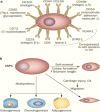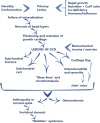Osteochondritis dissecans (OCD) in Horses - Molecular Background of its Pathogenesis and Perspectives for Progenitor Stem Cell Therapy
- PMID: 30796679
- PMCID: PMC6534522
- DOI: 10.1007/s12015-019-09875-6
Osteochondritis dissecans (OCD) in Horses - Molecular Background of its Pathogenesis and Perspectives for Progenitor Stem Cell Therapy
Abstract
Osteochondrosis (osteochondrosis dissecans; OCD) is a disease syndrome of growing cartilage related to different clinical entities such as epiphysitis, subchondral cysts and angular carpal deformities, which occurs in growing animals of all species, including horses. Nowadays, these disorders are affecting increasing numbers of young horses worldwide. As a complex multifactorial disease, OCD is initiated when failure in cartilage canals because of existing ischemia, chondrocyte biogenesis impairment as well as biochemical and genetic disruptions occur. Recently, particular attention have been accorded to the definition of possible relations between OCD and some metabolic disorders; in this way, implication of mitochondrial dysfunctions, endoplasmic reticulum disruptions, oxidative stress or endocrinological affections are among the most considered axes for future researches. As one of the most frequent cause of impaired orthopaedic potential, which may result in a sharp decrease in athletic performances of the affected animals, and lead to the occurrence of complications such as joint fragility and laminitis, OCD remains as one of the primary causes of considerable economic losses in all sections of the equine industry. It would therefore be important to provide more information on the exact pathophysiological mechanism(s) underlying early OC(D) lesions, in order to implement innovative strategies involving the use of progenitor stem cells, which are considered nowadays as a promising approach to regenerative medicine, with the potential to treat numerous orthopaedic disorders, including osteo-degenerative diseases, for prevention and reduction of incidence of the disease, not only in horses, but also in human medicine, as the equine model is already widely accepted by the scientific community and approved by the FDA, for the research and application of cellular therapies in the treatment of human conditions.
Keywords: Cartilage; Chondrocyte; Dissecans; Molecular events; Osteochondrosis; Regenerative medicine; Stem cells.
Conflict of interest statement
There is no conflict of interest.
Figures



Similar articles
-
Involvement of mitochondrial dysfunction and ER-stress in the physiopathology of equine osteochondritis dissecans (OCD).Exp Mol Pathol. 2014 Jun;96(3):328-38. doi: 10.1016/j.yexmp.2014.03.004. Epub 2014 Mar 20. Exp Mol Pathol. 2014. PMID: 24657499
-
Osteochondritis Dissecans Development.Vet Clin North Am Equine Pract. 2017 Aug;33(2):367-378. doi: 10.1016/j.cveq.2017.03.009. Epub 2017 May 25. Vet Clin North Am Equine Pract. 2017. PMID: 28551287 Review.
-
Omics technologies provide new insights into the molecular physiopathology of equine osteochondrosis.BMC Genomics. 2014 Oct 31;15(1):947. doi: 10.1186/1471-2164-15-947. BMC Genomics. 2014. PMID: 25359417 Free PMC article.
-
Arthroscopic reattachment of osteochondritis dissecans cartilage flaps of the femoropatellar joint: long-term results.Equine Vet J. 2011 Nov;43(6):650-9. doi: 10.1111/j.2042-3306.2011.00362.x. Epub 2011 Jun 8. Equine Vet J. 2011. PMID: 21649712
-
Emerging genetic basis of osteochondritis dissecans.Clin Sports Med. 2014 Apr;33(2):199-220. doi: 10.1016/j.csm.2013.11.004. Epub 2014 Jan 10. Clin Sports Med. 2014. PMID: 24698039 Free PMC article. Review.
Cited by
-
Simulation Study on the Integration of Health Traits in Horse Breeding Programs.Animals (Basel). 2020 Jul 7;10(7):1153. doi: 10.3390/ani10071153. Animals (Basel). 2020. PMID: 32645982 Free PMC article.
-
Osteoarthritis, adipokines and the translational research potential in small animal patients.Front Vet Sci. 2024 May 20;11:1193702. doi: 10.3389/fvets.2024.1193702. eCollection 2024. Front Vet Sci. 2024. PMID: 38831954 Free PMC article. Review.
-
Systemic Administration of Rejuvenated Adipose-Derived Mesenchymal Stem Cells Improves Liver Metabolism in Equine Metabolic Syndrome (EMS)- New Approach in Veterinary Regenerative Medicine.Stem Cell Rev Rep. 2019 Dec;15(6):842-850. doi: 10.1007/s12015-019-09913-3. Stem Cell Rev Rep. 2019. PMID: 31620992 Free PMC article.
-
Articular Cartilage Regeneration by Hyaline Chondrocytes: A Case Study in Equine Model and Outcomes.Biomedicines. 2023 May 31;11(6):1602. doi: 10.3390/biomedicines11061602. Biomedicines. 2023. PMID: 37371697 Free PMC article.
-
Subchondral defects resembling osteochondrosis dissecans in joint surfaces of the extinct saber-toothed cat Smilodon fatalis and dire wolf Aenocyon dirus.PLoS One. 2023 Jul 12;18(7):e0287656. doi: 10.1371/journal.pone.0287656. eCollection 2023. PLoS One. 2023. PMID: 37436967 Free PMC article.
References
-
- Jeffcott LB. Osteochondrosis - an international problem for the horse industry. Journal of Equine Veterinary Science. 1996;16(1):32–37.
-
- Carlson CS, Cullins LD, Meuten DJ. Osteochondrosis of the articular-epiphyseal cartilage complex in young horses: Evidence for a defect in cartilage canal blood supply. Veterinary Pathology. 1995;32(6):641–647. - PubMed
-
- Ekman S, Carlson CS. The pathophysiology of osteochondrosis. Veterinary Clinics of North America: Small Animal Practice. 1998;28(1):17–32. - PubMed
-
- Al-Hizab F, Clegg PD, Thompson CC, Carter SD. Microscopic localization of active gelatinases in equine osteochondritis dissecans (OCD) cartilage. Osteoarthritis and Cartilage. 2002;10(8):653–661. - PubMed
-
- Van Weeren PR, Olstad K. Pathogenesis of osteochondrosis dissecans: How does this translate to management of the clinical case? Equine Veterinary Education. 2016;28(3):155–166.
Publication types
MeSH terms
LinkOut - more resources
Full Text Sources
Research Materials

